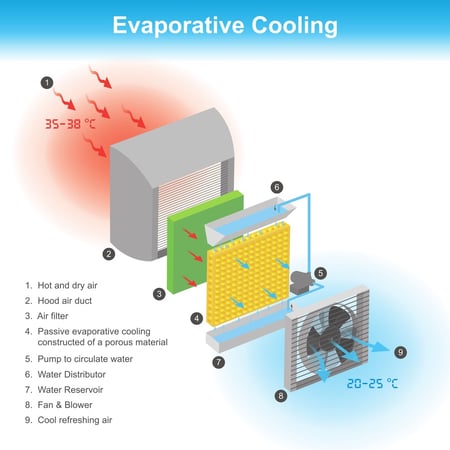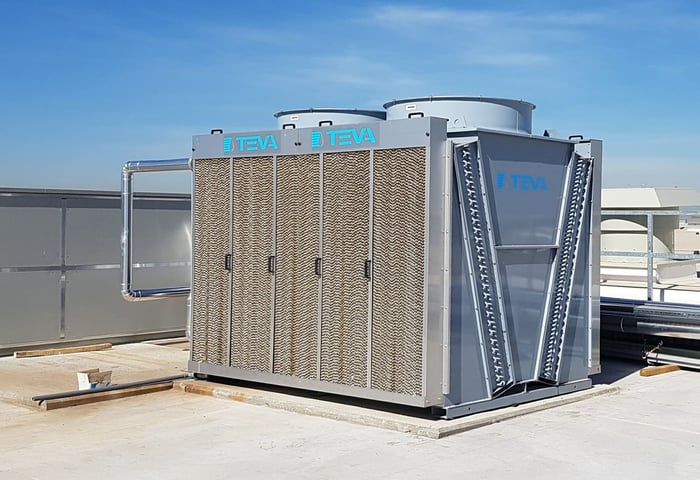In areas where summer is hot and dry, one of the cooling techniques that can be used is adiabatic cooling. This technique contributes to reducing the energy consumption of buildings, which can help in the design of nearly zero-energy buildings (nZEB).
This technique uses the natural process of water evaporation to cool the air. The method consists of passing the air through membranes impregnated with water that reduce the air temperature by a few degrees with hardly any cost. This is achieved because the water in the membranes, when evaporating in contact with the hot outside air, absorbs heat to make the phase change and therefore cools down.
In the HVAC of buildings, adiabatic cooling is used to cool the ventilation air entering the building. This is achieved by means of an adiabatic cooling coil and a fan. Hot air is drawn from the outside, it passes through the adiabatic coil, which dissipates the heat and converts it into cooled air. Then, the air is distributed throughout the building via the ventilation system.

Advantages and disadvantages of adiabatic cooling
The main advantage of adiabatic cooling is that it is very energy efficient, as it does not require the use of additional energy to cool the air. In addition, adiabatic cooling gently and evenly cools the air, which allows for greater comfort. Another advantage of adiabatic cooling is that it does not use cooling fluids that can be harmful to the environment, making it an option with less environmental impact.

On the downside, it should be noted that the efficiency of adiabatic cooling is limited by the humidity of the air. The more humid the air, the less cold can be added to the air. Outdoor air increases its relative humidity, which can be good in dry areas, but can be harmful in coastal areas where outdoor air is usually already humid.
On the other hand, it should be noted that the adiabatic cooling system can be very water-intensive, as water evaporates as the air passes through the membranes. Some systems also use a water mist to cool the air through the adiabatic process. In these cases, the water evaporates into the air and the heat dissipates, and then it is collected and reused. In general, the amount of water needed for an adiabatic cooling system will depend on the design of the system and the environment in which it is used.
Finally, they are complex systems that will require maintenance as the membranes become fouled over time and harmful bacteria can be created. Specifically, the mentioned systems that use a water mist for cooling can generate sources of Legionella.
Complement to adiabatic cooling systems
Adiabatic cooling often works in combination with other systems, as adiabatic cooling alone cannot guarantee comfort situations on the hottest summer days. The systems with which it is usually combined are the following:
- Water cooling: chilled water is used to cool the air by means of a heat exchanger. The water is cooled in a water cooling unit and then pumped through the heat exchanger, which is usually placed after the adiabatic coil, where the heat from the hot air is transferred to the cold water.
- Open geothermal cooling (Canadian well): heat from the ground is used to cool the air through a system of pipes buried in the ground. The hot air is drawn in by the system, passed through the adiabatic coil, and then introduced into the buried pipes to further lower its temperature and remove some of the moisture added when it comes into contact with the cold ground surrounding the buried pipes.
- Absorption cooling: a cooling fluid is used which is evaporated at low pressure and absorbed in an absorbent liquid. The liquid mixture is heated and the refrigerant evaporates, which cools down and is reabsorbed into the absorbent liquid.
Conclusion
Adiabatic cooling is a particularly useful technique in dry climates to help the cooling systems of buildings achieve a pleasant indoor temperature while reducing energy consumption. Although it requires some maintenance and has high water use, the pros and cons must be evaluated through energy simulations and life cycle cost studies to adequately assess its viability.


